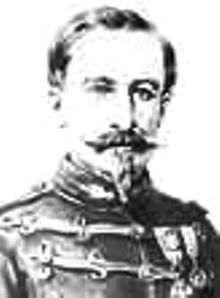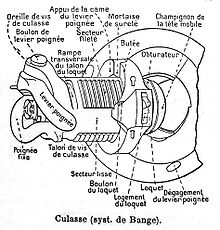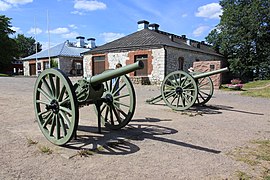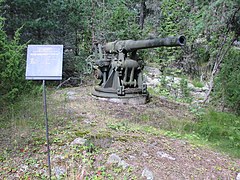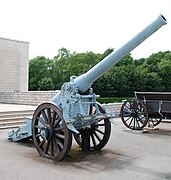Charles Valérand Ragon de Bange
Charles Valérand Ragon de Bange (born October 17, 1833 in Balignicourt , Aube , † July 9, 1914 in Le Chesnay near Versailles ) was a French polytechnician, colonel of the artillery and creator of a gun system that had been in good working order since the end of the 19th century proves to this day.
Military career
Ragon de Bange entered the École polytechnique in 1853 and became a sous-lieutenant in the artillery in 1857 . He then fought in the 8th e régiment d'artillerie and distinguished himself in the battle of Solferino . After returning to France, he first switched to technical service. Promoted to captain in 1862 , he served in the “9 e régiment d'artillerie” in Besançon from 1867 to 1869, before moving to the “Atelier de précision” of the “Dépôt Central” in Paris. He became Chief d'escadron in 1874 , Lieutenant-Colonel in 1878 and Colonel in 1880. He was awarded the Légion d'honneur in 1876, and in 1889 he became Commander of the Legion of Honor.
engineer
The defeat of France in the Franco-Prussian War and the rapid development of artillery material in the period after 1870 forced the French military leadership to think about innovations. First, the bronze de Reffye guns modéle 1870 and the steel “Lahitolle” (Modèle 1875) were converted into breech-loaders. The introduction of picric acid and the low-smoke powder (Poudre B) significantly improved the ammunition, but also forced the guns to be reinforced. In 1873 de Bange was commissioned to construct a light and a heavy field gun. De Bange introduced the Système de Bange in 1872 , which made it possible to seal the breech in a gas-tight manner and thus increase the effectiveness of the weapon. The previous systems suffered from the fact that gases and flames escaped from the breech, which not only endangered the gunners, but also led to an unsatisfactory loss of performance. The System de Bange was quickly adopted by the French artillery, the Royal Navy and the US Navy , as their large cannons still functioned as muzzle-loaders . They now had a special plastic lid ( seal ) made of asbestos and tallow .
Gun types
In 1873 he became director of the Ateliers de précision in the Dépôt Central de Paris, from where he supervised the redesign of all artillery pieces. He accomplished this task by developing:
- the Canon de 80 modèle 1877 mm for the mountain artillery;
- the Canon de Bange de 90 mm for field artillery;
- the Canon de 120 mm L modèle 1878 mm for the siege artillery;
- the Canon de Bange de 155 mm for the siege artillery;
- the Mortier de Bange de 220 mm for the siege artillery (1880);
- the Canon de 240 mm modèle 1884 mm for the siege and coastal artillery (1884);
- des Mortier de 270 modèle 1885 mm for the siege and coastal artillery (1885).
Between 1882 and 1890 de Bange was general director of the former Etablissements Cail, whose workshops were Grenelle (near Paris), Denain and Douai . He converted most of the factories into gun factories. In November 1884 he entered competition with Krupp with his field gun system when the Serbian field artillery was to be re-equipped. The Serbian government opted for the de Bange guns. In the Kingdom of Romania in 1885/86, after shooting attempts, the guns from Krupp were given preference over those from de Banges.
On the occasion of the world exhibition in Antwerp in 1885, de Bange set up a giant cannon. It consisted of steel with rings, had a caliber of 34 cm, a tube weight of 37,000 kg, a tube length of 11.20 m and fired projectiles weighing 420 to 600 kg with powder charges of 180 to 200 kg. It was supposed to shoot up to 18 km, but it shattered when it was fired for the third time in 1887.
Honors
In addition to the name of the system he invented, a street in Le Chesnay bears his name, and a school in the same town is named after him.
literature
- L'Encyclopédie internationale éditée par New Daniel Coit Gilman, Harry Thurston Peck, Frank Moore Colby - Encyclopédies et dictionnaires - 1902 Page 429 "De 1882 à 1889, il a été administrateur de la société Cail"
- Donald J. Stocker, Jonathan A. Grant: Girding for battle (preparation à la bataille). Ingrid A. Sandole-Staroste, p. 58.
Remarks
- ↑ [1] notice 28RT
- ↑ "One of the most efficient obturators not liable to damage is the plastic device introduced by Colonel de Bange of the French service" The Encyclopædia Britannica: A Dictionary of Arts, Sciences, Literature by Hugh Chisholm , p. 206.
- ^ "The De Bange gas-check, or" pad obturator "is the type used in the US Navy ... It is the invention of Colonel De Bange, of France" Naval Ordnance: A Text-book Prepared for the Use of the Midshipmen - Page 66 by Roland Irvin Curtin, United States Naval Academy, Thomas Lee Johnson
| personal data | |
|---|---|
| SURNAME | Bange, Charles Valérand Ragon de |
| ALTERNATIVE NAMES | Bange, Charles Ragon de |
| BRIEF DESCRIPTION | French artillery colonel |
| DATE OF BIRTH | October 17, 1833 |
| PLACE OF BIRTH | Balignicourt , Aube department |
| DATE OF DEATH | July 9, 1914 |
| Place of death | Chesnay near Versailles |
